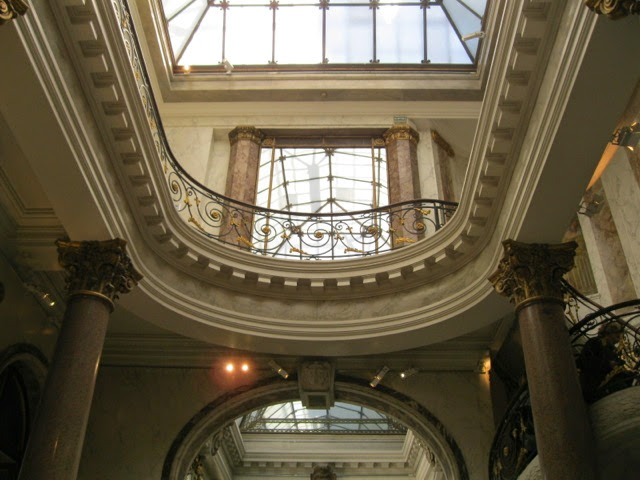Edouard André, head of a Protestant banking family (I don't know why being Protestant was important) devoted his considerable fortune to buying works of art. He then exhibited them in the new bachelor mansion he built in 1869 on Boulevard Haussmann in Haussmann's newly redesigned Paris.
In 1881, at the age of 48 he married a well-known society painter, Nélie Jacquemart, who had painted his portrait 10 years earlier. She was then 40. Every year the couple would travel to Italy, amassing one of the finest collections of Italian art in France, and taking the waters for their health.
When Edouard André died, aged 61, Nélie Jacquemart completed the decoration of their Italian Museum (three large rooms on the upper floor of the mansion) and travelled extensively in the Orient to add more precious works to their collection.
Faithful to the plan agreed with her husband, she bequeathed the mansion and all its collected treasures to the Republic of France to be used for a museum. It opened to the public in 1913.
This is the front of the house but it does not face Bld Haussmann in the tradional French style, it faces the sun and the huge interior walled courtyard into which many carraiages at a time, and later cars could drive into and then wait.
Like all grand houses it is divided into reception rooms and private quarters. The Jacquemart-Andrés had no children so their private quarters were not extensive. However, their collections were so vast that they needed many rooms in which to display them. And because many people visited, the rooms needed to be on the largish size.
This (and the photo above) is the waiting room where guests would wait before being invited into the grand salon to meet their host and hostess. One displayed one's very best pictures here, presumably because one had a captive audience.
The window side of the oval shaped grand salon looking onto the Blvd Haussmann.
Standing at the windows and looking back into the room. Both the wall panelling and the parquet floor were absolutely superb. Because of the panelling, the room is not suitable for paintings but contains a fabulous collection of marble busts.
There would have been some seating in this room but in streamlining buildings like this for visitors, often seating is removed to ease congestion. Because there are no people in my photographs, you can't really appreciate how large the room is.
Looking through a side window across the face of the three large reception rooms that all open onto this broad terrace looking out over the grand boulevard. I can visualise this terrace full of people on a warm summer evening, with the huge glass windows open and music flowing into the street.
The grand music room, which is surrounded by a first floor gallery. There was a grand organ in this room when Edouard was alive as he loved to play and was very good.
The grand music room leads into the winter garden. The three main reception rooms can hold 1,000 people and often did as Parisian society flocked to see the magnificent collections of Edouard and Nélie.
The winter garden is characteristic of the art of entertaining which developed under Napoleon III.
Imported from Great Britain, the winter garden idea was very popular consisting of exotic pot plants under the cover of a glass roof. This greened space gave guests somewhere to rest for a moment in a refreshing environment away from the oppressive neighbouring rooms.
The vestible is paved in marble, its walls adorned with mirrors leading to an astonishing double helix staircase which is decorated with sculptures, turning it into a gallery of antiques.

despite the fabulous antiques, the plants ranged around remind us that this room was initially a winter garden, suffused by the light falling through the glass roof.
When the mansion was opened by Edouard and Nélie, this was the room that impressed contemporary visitors the most.
In 1876 the magazine L'Illustration reported: "The marvel of this marvellous palace was indisputably the winter garden. Our great ladies of fashion found refuge there to avoid the crowds. Only a king or a banker would surely dare to surround himself with such sumptuousness."
The story goes that the designer of the staircase had just missed out on the contract to build the grand staircase at the Opera Garnier, the new opera building commissioned by Napoleon III in Haussmann's redesigned Paris. So Edouard and Nélies architect quickly commissioned the young designer to apply his loosing design to the new winter garden extension planned by the Jacquemart-Andrés.
Looking down onto the superb parquet floor of the music room from the first floor balcony.
Nélie's bedroom in Louis XV style.
The pale almond and pale grey silk is stunning and the matching screens on either side of the bed could be worth millions.
Edouard's room is plainer but still shows Nélie's touch.
Edouard's adjoining bathroom. We didn't see Nélie's bathroom ..... maybe they shared?
As I was writing this I came across another regional museum, about 65km outside Paris which houses 6,000 items of art from Nélie's estate. I suppose they must be the items that the curators of this museum can't find a place for here.






















No comments:
Post a Comment